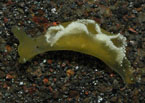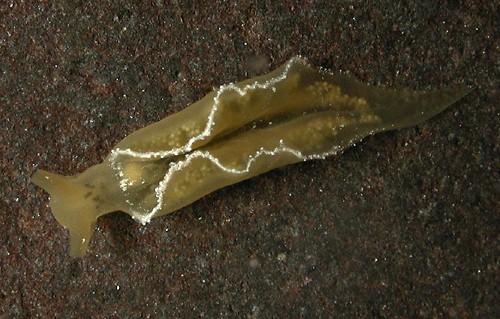| Home |
| Acknowledgments |
| Conventions |
| Glossary |
| Maps |
| References |
| Links |
| Articles |
| Thumbnails |
| Species
list |
| Family |
| Next
species |
Additional Photos

bright
dark pigment

more white

young, 5 mm
egg mass
_______________
GALLERY

Elysia obtusa Baba, 1938

| Maximum size: 22 mm. Identification: This species has moderately tall parapodia that meet in a frilly margin. There are widely scattered papillae that become much more prominent on the parapodial margin. It is usually bright yellow with minute rust-brown flecks, scattered white spots, and a white marginal band on the parapodia. Some animals, however, have dark interior pigment. (Note 1) Rarely, there may be a more extensive dusting of white flecks on the interior of the parapodia and rhinophores. Natural history: Elysia obtusa is a moderately rare plakobranchid found on shallow rocky bottoms. It occurs in highly protected to moderately protected locations from the low intertidal to depths of 1.5 m (5 ft). Mature animals are nocturnally active. The lack of consistent dark pigment suggests that it does not store chloroplasts. A 7.5 mm animal laid a tightly coiled, pale orange egg mass. It had evenly spaced "knobs" on the outer surface of the outer whorls that were filled with dark orange extra-capsular yolk. Hatching occurred in about seven days in the laboratory. The extra-capsular yolk remained in the egg mass after hatching. Distribution: Big Island, Maui, Oahu, Kauai, French Frigate Shoals and Pearl & Hermes Reef: widely distributed in the Indo-Pacific Taxonomic notes: This species was previously lumped with Atlantic animals under the name Elysia flava Verrill, 1901 and it is listed under that name in many older sources. It was first recorded in Hawaii from Hekili Point, Maui by CP on May 9, 1992. Recent DNA results from Kaneohe Bay (and elsewhere) suggest that there may be two cryptic species lumped under the name in the Indo-Pacific (though only one in Hawaii) making use of the name for the Hawaiian population uncertain. (Gustav Paulay, pers. com.). Photo: CP: 7.5 mm: Hekili Point, Maui; April 16, 2006. Observations and comments: Note 1: An animal with dark pigment changed to "all yellow" after laying eggs suggesting that the dark color may be due to some compound involved in egg laying (a precursor to the extra-capsular yolk?) rather than retained chloroplasts. (see photos) |
| Thumbnails |
Species
list |
Family | Next species | Top |